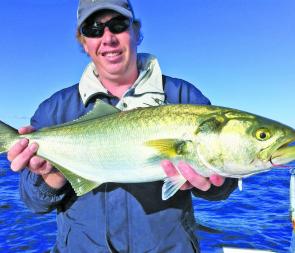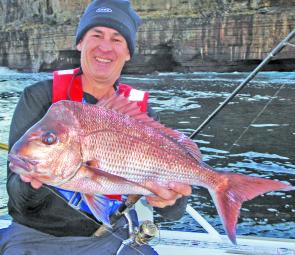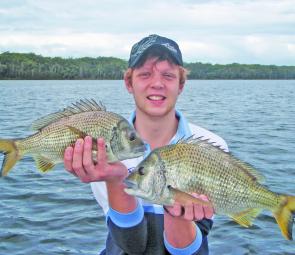I love this time of year. Not only because I’m having more afternoon siestas on the lounge in front of the fire, but the serenity – how’s the serenity?
Quiet waterways, no crowds, and no morons roaring past a boat length away at full noise! And I even get a few jobs done around the house, which keeps the missus happy, too.
July means big reddies in close, particularly after a bit of weather.
There are a few keys to the shallow-water reds at this time of year and the main one would have to be cuttlefish.
The cuttlefish will be ending their 18-month life cycle before they become an important food source not only for Mr Red, but also dolphins and albatrosses, to name a few.
These cuttlefish can grow to 1m long and are a vital food source after they mate and then start to weaken. High concentrations of these slimy cephalopods gather on inshore reefs over the next few months and snapper arrive in numbers in anticipation of an easy meal.
Your main target will be the dead cuttlefish, which float to the surface thanks to their buoyant skeleton.
Cast lightly weighted 4” Gulp Swimming Mullet in pumpkinseed around these floating smorgasbords for reds near the surface. The action has to be seen to be believed.
Take a feed and treat any very large red caught in less than 10m with respect and return it to the water. These are valuable brood stock and can be successfully released with no harm done from barotrauma.
I now get more of a rush from watching a big red swim away than I do catching them.
If lures aren’t your thing then a fresh piece of blue pilchard or peeled prawn thrown into a wash is a recipe for good reds, bream and drummer at this time of year.
If your shore-based, bread berley is essential to get things fired up.
Blackfish are in all the usual haunts on the ledges around Jervis Bay and are a great Winter species to target for a feed.
Check the weather before you hit the rocks and tell someone where you’re going and what time you’ll return.
Jumbo tailor have been on the chew for a few months now in many of the recreational fishing havens in the area. Fish of 3 kg to 5kg have been common and why not? There’s been plenty of bait and not much in the way of competition.
Always have a specific tailor rig ready to cast into a feeding frenzy if they’re on the surface. Look for small groups of diving crested terns as a sure-fire indicator of choppers on the surface.
My standard tailor rig is now 6lb braid with a double tied with a double uni to about half a metre of 60lb fluorocarbon leader and a small, and I mean small, baitfish profile metal lure.
You can cast it a mile or drop it down and jig if the fish have dived.
I’ve also been having great success with the downrigger in this department. Now there’s no more weed fouling the lure, which has massively increased our hook-up rates. Best lures have been Rapala X-Raps.
Those chucking lures for bream will be complaining about all the flathead they catch in the shallows on hardbodies.
And the majority of estuary bream will be schooled up in the deeper sections of most estuaries, with blades the weapons of choice at this time of year.
There will also be those who want to spend long, freezing nights soaking butterflied mullet and squid baits in the lower sections of the Shoalhaven River for jewies. But you can have that because I’d rather be tucked up in bed and chucking plastics by day, thank you very much.
Don’t forget zero bag limits for bass and EPs are in force until September. Fisheries literature states, ‘These great native sports fish can be vulnerable to fishing when they are in large groups. The zero bag limit was introduced from feedback from the community after a three-year review into NSW recreational fishing rules.’
One thing worth a mention. When venturing offshore at this time of year look out for whales. Yes, they taste like chicken but they also grow to 15m long and weigh over 40 tonnes and do damage to moving boats.
It pays to keep a sharp lookout from now until late November.
In recent days yellowfin tuna around 15kg to 20kg have finally shown up in patches. Let’s hope the bluefin not only show, but come in close.
Keep your eyes on the sea surface temps and look for a nice break in the weather.
Reads: 2836
It's not a kingfish it's a big chopper!

Angelo Musumeci of Jervis Bay Fishing Charters with a red from the washes on 6lb bream gear.

Blackfish master Dave Johnson with a tasty specimen from the stones.

Luke Jokovic with a total of 84cm worth of bream he caught and released on one memorable Autumn day.

The Big E and Paul Worsteling with a catch-and-release 92cm Basin big girl. Note the correct handling.




